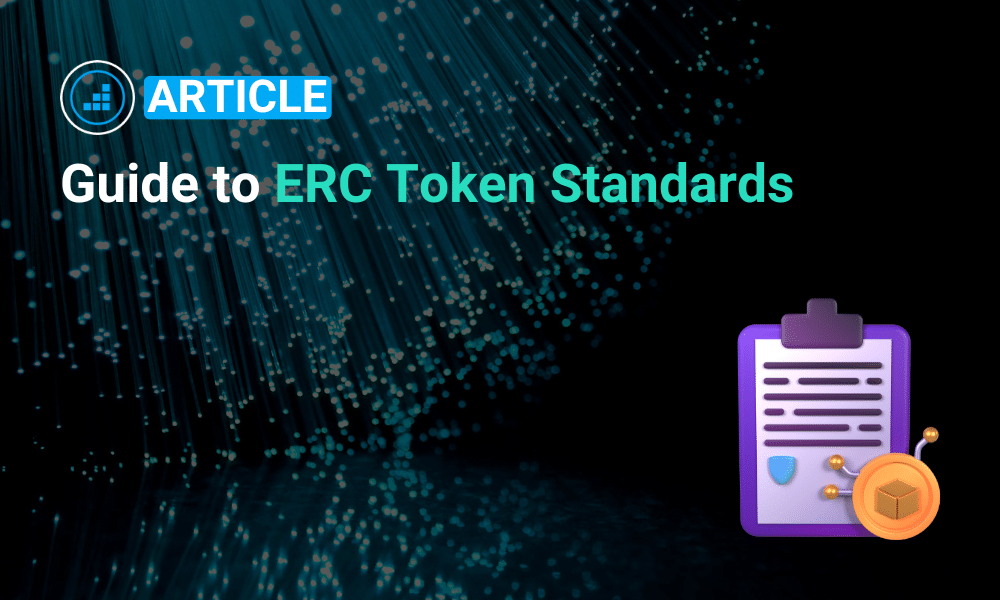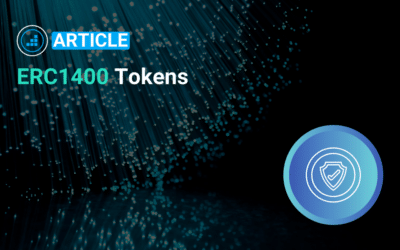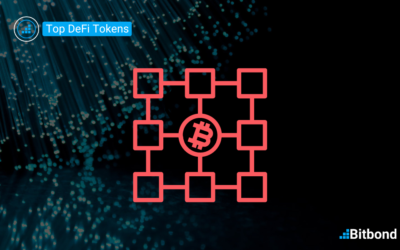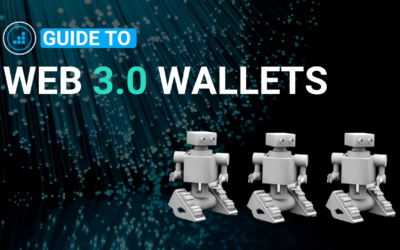Table of Contents
ERC Token standards represent the foundation of blockchain tokenization and token contracts running on Decentralized Ledger Technology. What are ERC token standards? What advantages do they offer? Learn more in this article.
Overview of ERC Token Standards
ERC-20: The ERC token standard for fungible tokens
Definition and key characteristics
The ERC-20 token standard is a cornerstone in the Ethereum blockchain, serving as the blueprint for creating fungible tokens—tokens that are interchangeable and hold equal value with one another.
This standard defines a set of rules and functions that a token must implement, ensuring interoperability across the Ethereum ecosystem. A crucial aspect of ERC-20 is its interface, which provides a standardized method for tokens to communicate with applications and other tokens on the Ethereum network. This interface facilitates seamless interactions, such as transferring tokens or querying balances, making it integral to the fluidity and efficiency of the Ethereum ecosystem.
Key characteristics of ERC-20 include uniformity in the creation process, ease of exchange, and compatibility with wallets and exchanges. This standard primarily facilitates the issuance of tokens for various applications, such as utility tokens in decentralized applications (dApps) or as digital assets.
Its widespread adoption is attributed to its simplicity and effectiveness in providing a consistent and reliable framework for token creation and management, making it a fundamental component in the landscape of digital assets on Ethereum.
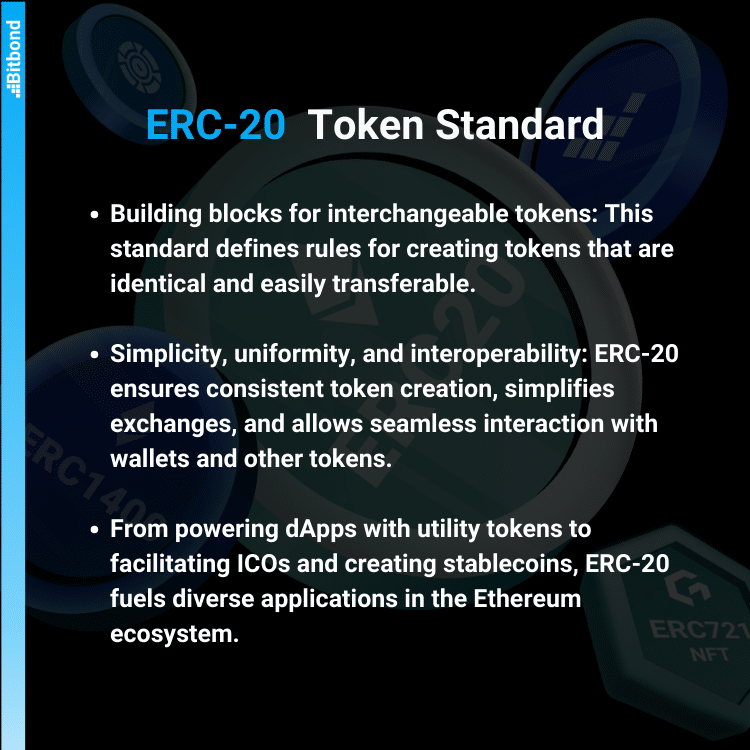
Use cases
The ERC-20 standard has catalyzed a diverse range of applications within the Ethereum ecosystem. Primarily, it is used for creating utility tokens in decentralized applications (dApps), where these tokens can serve various roles such as granting access to certain functionalities or incentivizing user engagement.
In the realm of digital finance, ERC-20 tokens are often employed for Initial Coin Offerings (ICOs), allowing startups and projects to raise capital by issuing their own digital tokens. Moreover, ERC-20 tokens have also found significant use in creating stablecoins—digital currencies pegged to stable assets like fiat currencies, offering a less volatile option for cryptocurrency users. These wide-ranging applications showcase ERC-20’s versatility and foundational role in the flourishing landscape of blockchain-based innovations.
ERC-721: Pioneering Non-Fungible Tokens (NFTs)
Definition and how it differs from ERC-20
ERC-721, a distinct erc token standard on the Ethereum blockchain, marks a significant departure from the ERC-20 by introducing the concept of Non-Fungible Tokens (NFTs). Unlike ERC-20 tokens, which are fungible and interchangeable, each ERC-721 token is unique and cannot be exchanged on a one-to-one basis with another.
This uniqueness is achieved through a detailed attribution process, where each token can have distinct characteristics and values. ERC-721 tokens are predominantly used in applications that require unique digital items, such as digital art, collectibles, and ownership records for digital or physical assets.
The introduction of ERC-721 has heralded a new era in digital ownership and collectability, enabling the blockchain to verify and display ownership of individual, unique items. This standard has thus unlocked a wealth of possibilities in the realms of digital art, gaming, and beyond, fundamentally altering how digital assets are valued and exchanged in the Ethereum ecosystem.
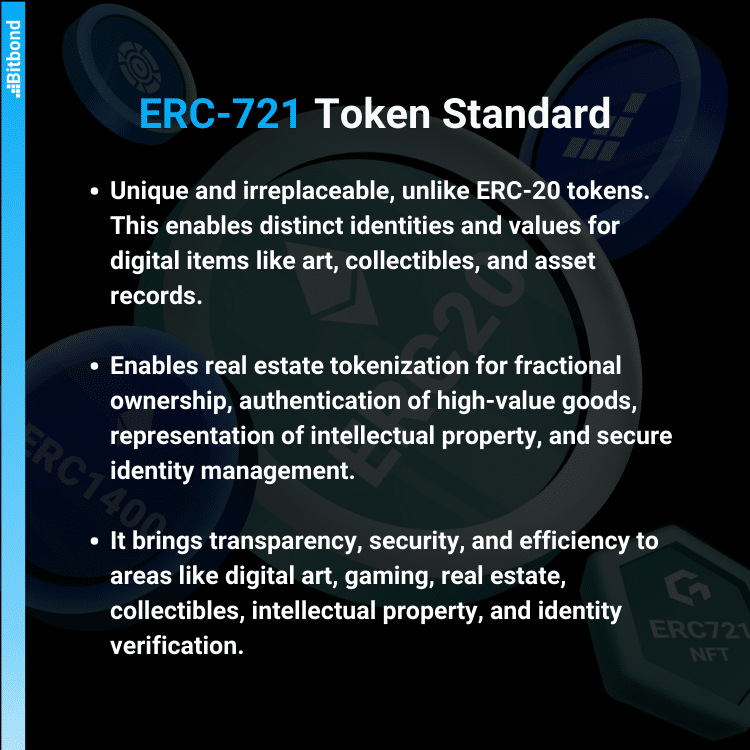
Use cases
ERC-721 tokens, known for their uniqueness and non-fungibility, have applications far beyond just digital art, extending significantly into traditional wealth management areas. One of the most promising uses is in real estate tokenization, where individual properties can be represented as unique digital assets on the blockchain.
This enables fractional ownership, increased liquidity, and simplified transfers of property rights. Another use case lies in collectibles and luxury goods, where ERC-721 tokens can authenticate and verify the ownership of high-value items like rare wines, vintage cars, or luxury watches. In the field of intellectual property and patents, these tokens offer a novel way to represent and trade intellectual rights, making it easier to monetize and manage these assets.
Additionally, ERC-721 tokens are also being explored for use in identity verification and management, providing a secure and immutable record of personal and professional credentials. These diverse applications demonstrate the potential of ERC-721 tokens to revolutionize traditional asset management and ownership structures, bringing increased transparency, security, and efficiency to these sectors.
ERC-1155: The Multi-Token Standard
Explanation of its multi-token functionality
ERC-1155 represents a significant evolution in the Ethereum erc token standards, introducing a multi-token framework that allows for both fungible and non-fungible tokens to be managed under a single contract.
This hybrid standard addresses the limitations of both ERC-20 and ERC-721 by enabling a more efficient and flexible approach to token management on the Ethereum blockchain. With ERC-1155, a single smart contract can represent a wide array of assets, from interchangeable tokens akin to ERC-20 to unique, indivisible tokens similar to ERC-721, and even a combination of both.
This multi-token capability simplifies transactions, as it allows for batch transfers of diverse types of tokens, reducing transaction costs and improving blockchain efficiency. Particularly advantageous in gaming and digital asset realms, ERC-1155 enables complex operations, such as trading multiple types of items simultaneously, and facilitates more nuanced asset interactions.
Its adoption marks a step towards a more versatile and dynamic ecosystem for digital assets on Ethereum, showcasing the evolving nature of erc token standards in accommodating diverse use cases.
Use cases in gaming and digital assets
The ERC-1155 token standard’s multi-token functionality opens up innovative use cases in the gambling and digital assets sectors. In the world of online gambling and gaming, ERC-1155 facilitates the creation of in-game assets that can range from fungible tokens, like in-game currency, to unique items like rare collectibles or equipment.
This versatility allows for a more immersive and integrated gaming experience, where players can easily trade, upgrade, or combine different types of assets within a single platform. The ability to execute batch transfers under one transaction also streamlines the process, making in-game economies more efficient and player-friendly.
In the realm of digital assets, ERC-1155’s flexibility is instrumental in creating and managing digital collectibles, which can include anything from digital art to virtual real estate. It supports the concept of fractional ownership of high-value digital assets, allowing them to be broken down into smaller, more affordable shares. This not only democratizes access to these assets but also enhances their liquidity in the market.
Moreover, ERC-1155’s efficiency in handling multiple asset types in a single transaction makes it an ideal standard for platforms that deal with a variety of digital assets, fostering a more interconnected and dynamic digital asset ecosystem.
ERC-1400: The ERC token standard for security tokens
Focus on security tokens and compliance features
ERC-1400 emerges as a specialized erc token standard on the Ethereum blockchain, specifically designed to cater to the needs of security tokens. This standard integrates the principles of traditional financial securities with blockchain technology, offering a framework that is compliant with legal and regulatory requirements.
A key feature of ERC-1400 is its emphasis on compliance and investor protection, ensuring that token issuances and transfers adhere to relevant laws and regulations. This includes mechanisms for enforcing trading restrictions, managing investor qualifications, and ensuring transparency in transactions.
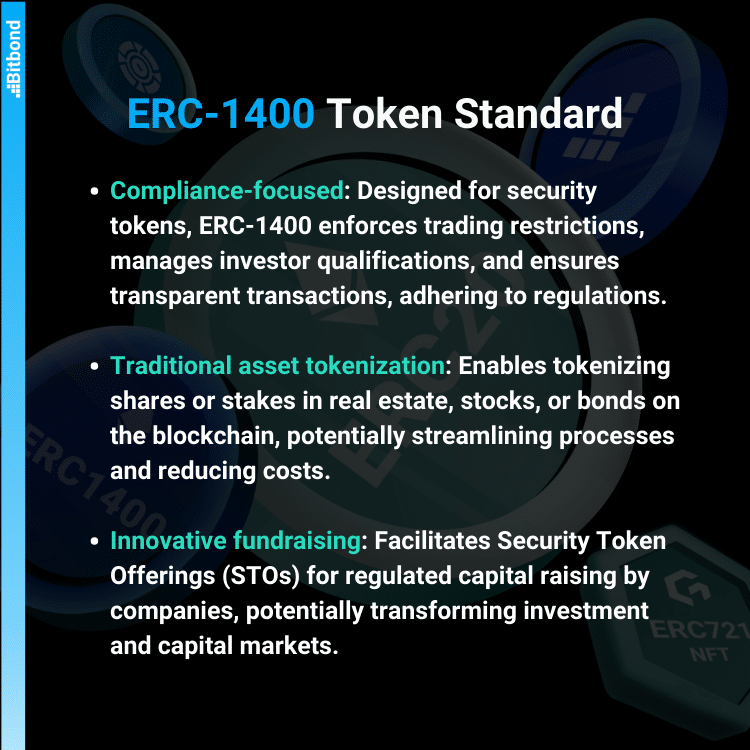
Potential impact on traditional finance and asset tokenization
One of the most notable applications of ERC-1400 is in the tokenization of traditional financial assets. This could include stocks, bonds, or real estate, where each token represents a share or a stake in the underlying asset. By leveraging blockchain technology, ERC-1400 can streamline processes like issuance, trading, and settlement, enhancing efficiency and reducing costs in the financial markets.
Additionally, ERC-1400 tokens can facilitate innovative fundraising methods like Security Token Offerings (STOs), providing companies with a regulated way to raise capital by issuing digital securities. This approach combines the advantages of blockchain technology, like immutability and transparency, with the regulatory safeguards necessary for financial securities, potentially transforming the landscape of investment and capital markets.
Comparative analysis of ERC token standards
In this chapter, we delve into the evolution and market adoption of various erc token standards. By comparing ERC-20, ERC-721, ERC-1155, and ERC-1400, we gain insights into their unique functionalities, limitations, and the specific niches they occupy in the blockchain ecosystem.
| Standard | Purpose | Functionalities | Limitations |
|---|---|---|---|
| ERC-20 | For creating fungible tokens used in a wide range of applications like ICOs, utility tokens | – Uniform token creation – Ease of exchange – Wide wallet/exchange compatibility – Popular for ICOs | – Only for fungible assets – No unique token identification – Higher transaction costs for bulk transfers |
| ERC-721 | For creating unique, non-fungible tokens, ideal for digital collectibles, art, and asset ownership | – Unique, non-fungible tokens – Ideal for digital collectibles/art – Proof of digital/physical asset ownership – Enables digital uniqueness | – More complex than ERC-20 – Not suitable for fungible assets – Higher gas costs per transaction |
| ERC-1155 | A versatile standard for managing both fungible and non-fungible tokens, especially useful in gaming and digital assets | – Fungible & non-fungible in one contract – Batch transfer of diverse assets – Optimized for gaming/digital assets – Efficient asset management | – Less established, newer standard – Complex handling of mixed asset types |
| ERC-1400 | For issuing and managing security tokens, aligning blockchain assets with regulatory compliance | – Compliant with regulatory standards – Suitable for traditional securities – Enforces trading restrictions – Facilitates STOs | – Complex regulatory compliance – Limited to security tokens – Requires intricate legal structuring |
Key Insights
The comparative analysis underscores the dynamic nature of erc token standards, each serving distinct purposes and evolving to meet diverse market needs. ERC-20’s widespread adoption for fungible tokens, ERC-721’s pioneering role in NFTs, ERC-1155’s versatility in handling both fungible and non-fungible assets, and ERC-1400’s compliance-oriented approach for security tokens, collectively illustrate the robust and adaptable framework Ethereum offers for digital asset innovation.
This diversity not only reflects the evolving demands of the blockchain sector but also highlights the potential for future standards to further expand Ethereum’s capabilities in the digital economy.
Which standard is suitable for which use case?
In the diverse landscape of tokenization on the Ethereum blockchain, each erc token standard finds its niche, addressing specific use cases with tailored functionalities. ERC-20, being the first and most widely adopted, is ideal for creating fungible tokens like cryptocurrencies, utility tokens in decentralized applications, and digital assets in ICOs. Its uniformity and exchangeability make it a staple for applications requiring standardization and liquidity. ERC-721, on the other hand, excels in representing unique, non-fungible assets, making it the standard of choice for digital art, collectibles, and any application where uniqueness and proof of ownership are paramount. This standard has been pivotal in the emergence of the NFT market, enabling the tokenization of one-of-a-kind digital and physical assets.
The ERC-1155 standard, with its ability to handle both fungible and non-fungible tokens, is particularly well-suited for the gaming industry and digital content markets, where a mix of asset types (like in-game currencies, equipment, and collectibles) can be managed within a single contract. This versatility and efficiency make it a game-changer for platforms that deal with a variety of token types. Lastly, ERC-1400 emerges as the go-to standard for security tokens, catering to the financial industry’s need for regulatory compliance and legal rigor. It’s particularly applicable for tokenizing traditional securities, real estate, and other assets in a regulated environment, ensuring adherence to legal standards and investor protection.
Conclusion
As we reflect on the remarkable journey of erc token standards on the Ethereum blockchain, it’s evident that the strides made in tokenization represent significant technological progress. The evolution from ERC-20’s pioneering role in establishing fungible tokens to the nuanced functionalities of ERC-721, ERC-1155, and ERC-1400 showcases a landscape rich in innovation and adaptability. The adoption of these standards across various sectors, from digital art and gaming to traditional financial securities, highlights the growing confidence in blockchain technology’s ability to revolutionize asset management and ownership.
However, this journey is not without its challenges. The landscape of tokenization still grapples with issues such as regulatory uncertainty, scalability concerns, and the need for wider understanding and acceptance of blockchain technology. Additionally, the complexity of integrating these standards into existing legal and financial frameworks presents an ongoing challenge. Ensuring security, compliance, and interoperability remains paramount as we advance further into this domain.
In conclusion, while we celebrate the technological achievements and the adoption of tokenization, it’s crucial to remain cognizant of the hurdles that lie ahead. The continuous evolution of token standards, coupled with collaborative efforts among developers, regulators, and industry stakeholders, will be key in overcoming these challenges. The future of tokenization, ripe with potential, hinges on our collective ability to innovate, regulate, and educate, paving the way for a more inclusive and efficient digital economy.

